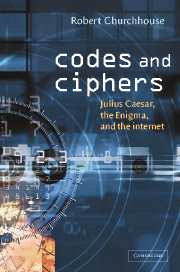Book contents
- Frontmatter
- Contents
- Preface
- 1 Introduction
- 2 From Julius Caesar to simple substitution
- 3 Polyalphabetic systems
- 4 Jigsaw ciphers
- 5 Two-letter ciphers
- 6 Codes
- 7 Ciphers for spies
- 8 Producing random numbers and letters
- 9 The Enigma cipher machine
- 10 The Hagelin cipher machine
- 11 Beyond the Enigma
- 12 Public key cryptography
- 13 Encipherment and the internet
- Appendix
- Solutions to problems
- References
- Name index
- Subject index
1 - Introduction
Published online by Cambridge University Press: 13 August 2009
- Frontmatter
- Contents
- Preface
- 1 Introduction
- 2 From Julius Caesar to simple substitution
- 3 Polyalphabetic systems
- 4 Jigsaw ciphers
- 5 Two-letter ciphers
- 6 Codes
- 7 Ciphers for spies
- 8 Producing random numbers and letters
- 9 The Enigma cipher machine
- 10 The Hagelin cipher machine
- 11 Beyond the Enigma
- 12 Public key cryptography
- 13 Encipherment and the internet
- Appendix
- Solutions to problems
- References
- Name index
- Subject index
Summary
Some aspects of secure communication
For at least two thousand years there have been people who wanted to send messages which could only be read by the people for whom they were intended. When a message is sent by hand, carried from the sender to the recipient, whether by a slave, as in ancient Greece or Rome, or by the Post Office today, there is a risk of it going astray. The slave might be captured or the postman might deliver to the wrong address. If the message is written in clear, that is, in a natural language without any attempt at concealment, anyone getting hold of it will be able to read it and, if they know the language, understand it.
In more recent times messages might be sent by telegraph, radio, telephone, fax or e-mail but the possibility of them being intercepted is still present and, indeed, has increased enormously since, for example, a radio transmission can be heard by anyone who is within range and tuned to the right frequency whilst an e-mail message might go to a host of unintended recipients if a wrong key on a computer keyboard is pressed or if a ‘virus’ is lurking in the computer.
- Type
- Chapter
- Information
- Codes and CiphersJulius Caesar, the Enigma, and the Internet, pp. 1 - 12Publisher: Cambridge University PressPrint publication year: 2001



